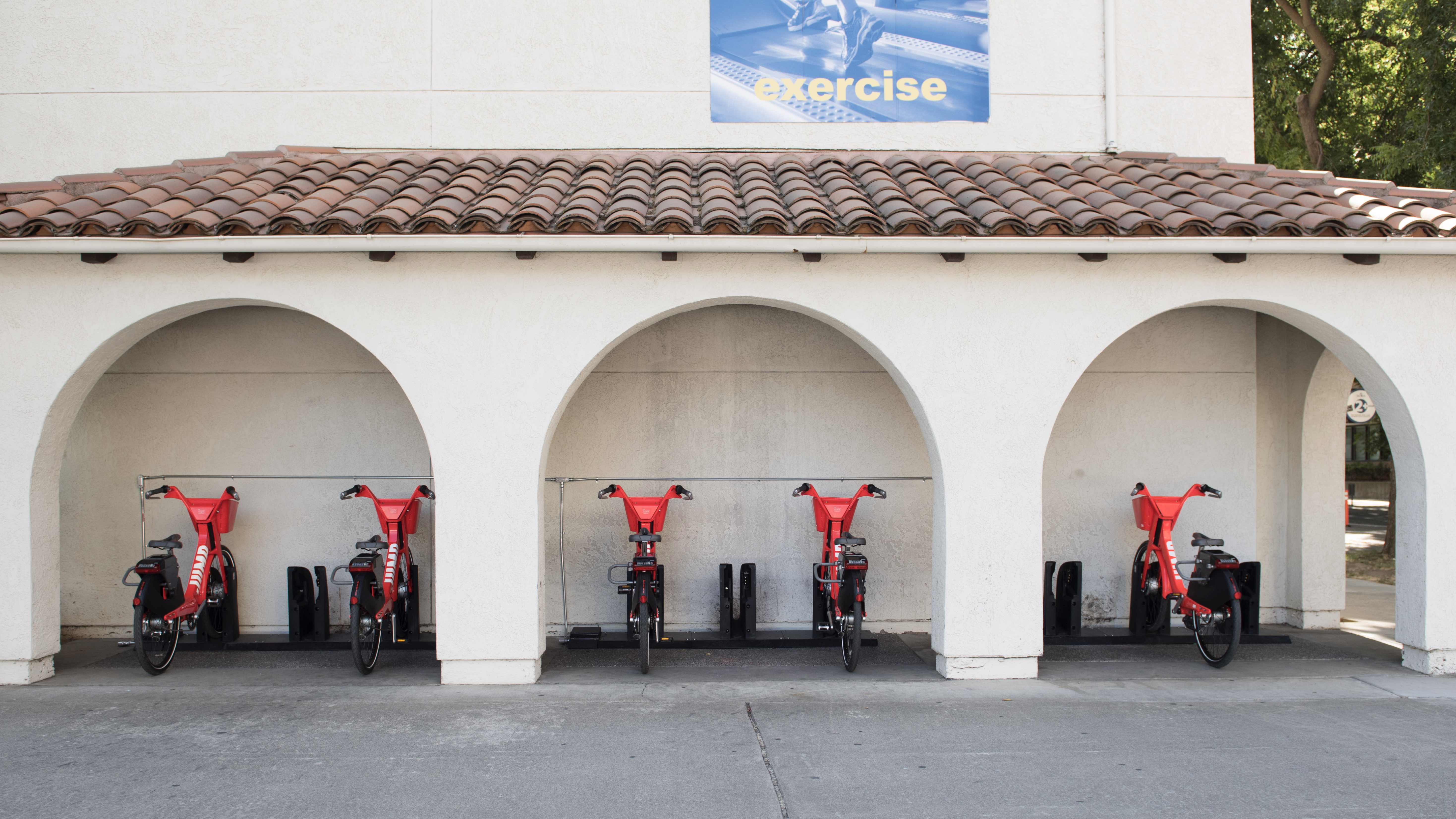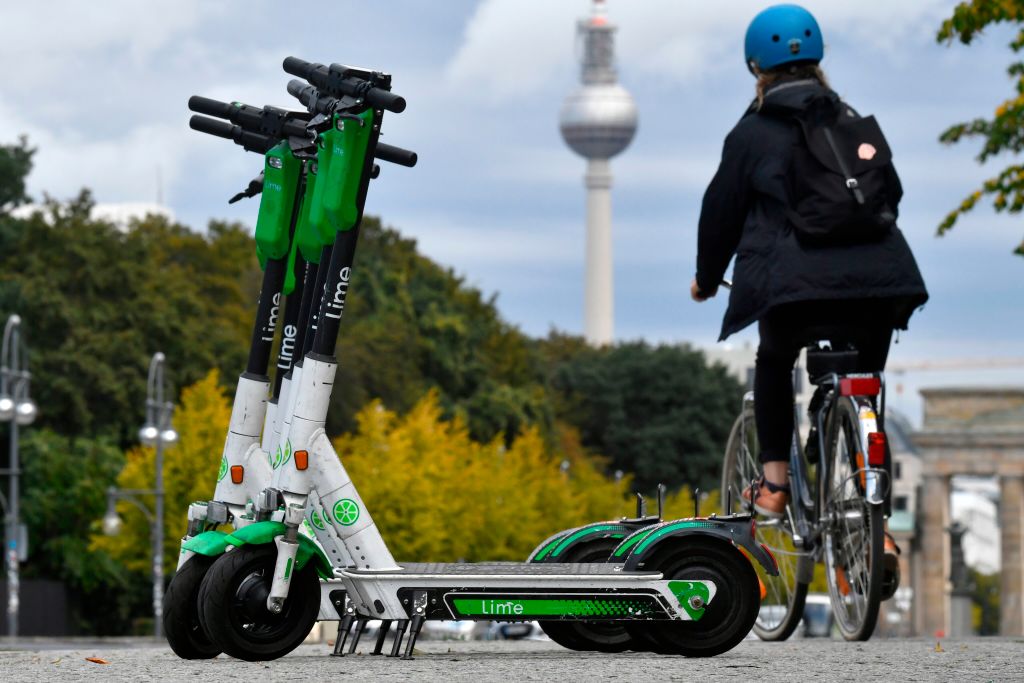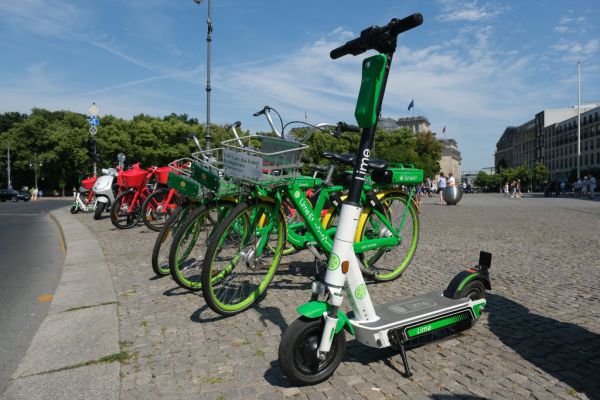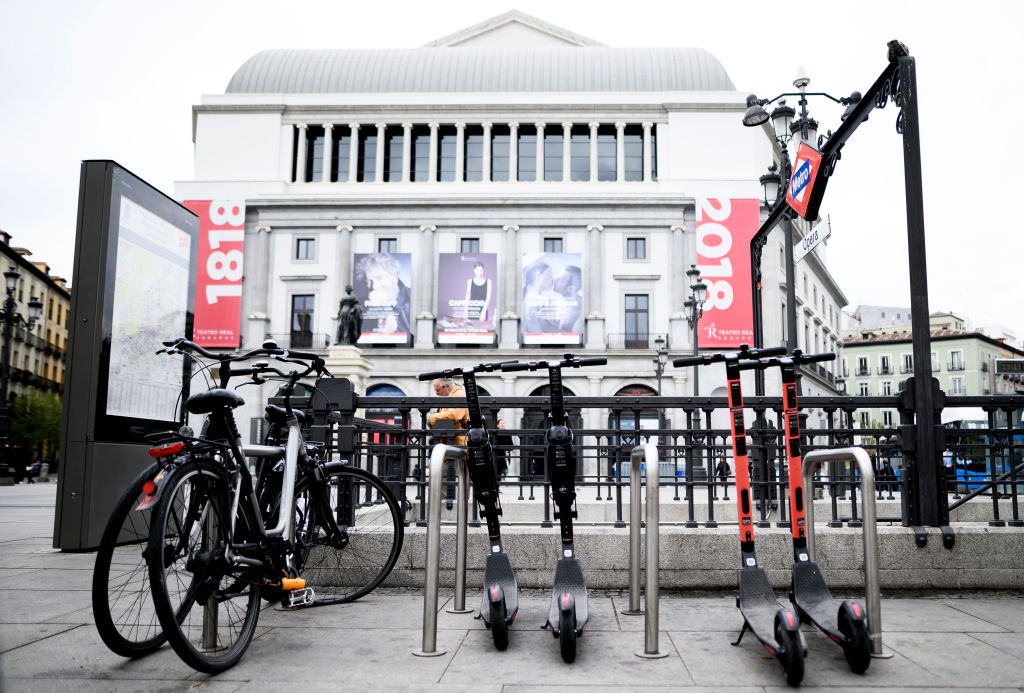Micromobility has taken off over the last couple of years. Between electric bike-share and scooter-share, these vehicles have made their way all over the world. Meanwhile, some of these companies, like Bird and Lime, have already hit unicorn status thanks to massive funding rounds.
Horace Dediu, the well-known industry analyst who coined the term micromobility as it relates to this emerging form of transportation, took some time to chat with TechCrunch ahead of Micromobility Europe, a one-day event focused on all-things micromobility.
We chatted about the origin of the word micromobility, where big tech companies like Apple, Google and Amazon fit into the space, opportunities for developers to build tools and services on top of these vehicles, the opportunity for franchising business models, the potential for micromobility to be bigger than autonomous, and much more.
Here’s a Q&A, which I lightly edited for length and clarity, I did with Dediu ahead of his micromobility conference.
Megan Rose Dickey: Hey, Horace. Thanks for taking the time to chat.
Horace Dediu: Hey, no problem. My pleasure.
Dickey: I was hoping to chat with you a bit about micromobility because I know that you have the big conference coming up in Europe, so I figured this would be a good time to touch base with you. I know you’ve been credited with coining the term micromobility as it relates to likes of shared e-bikes and scooters.
So, to kick things off, can you define micromobility?
Dediu: Yes, sure. So, the idea came to me because I actually remembered microcomputing.
Microcomputing was the word we used before we used the word PC, to describe this new generation of computers that were based on microprocessors. And of course, the name microprocessor came because the idea was to, you know, take a processor, which was something made up of multiple chips and combine it into one chip and make it very small.
And so that idea of shrinking the computer to something that was desktop, at the time, this is the late-70s, was similar in what I observed was the process of shrinking personal transportation to vehicles that were much smaller than what we had before.
And the thing about the very small computer, of course, it was a full computer, it was not a calculator. we had calculators that were small, but these were real computers, these were things which did what are called, you know, multitasking, and they ran an operating system and all of that.
So what we see today with this new definition of personal transportation is that these vehicles have a lot of the features, all the bigger cousin, you know, they have, in many cases, you know, electric power they have onboard communications, they have onboard displays and in many cases, these are these are just a getting around as the big machines are. So that was the analogy. And that was the way I thought about the term capturing this idea.

Now to define it more precisely is a challenge because of course, we have legacy vehicles that are included in many cases that are not powered, like bicycles, or even kick scooters. And we have a lot of motorcycles and mopeds. And we even have sort of really small electric cars, like in a form of golf cars.
My problem has not been that, you know, the idea is simple. But to define it precisely. And what to include and what not to exclude is an ongoing debate, rather than get deep into that question about, you know, what is in and what is not.
And, and this gets very political because a lot of the legacy vehicles have some infrastructure or legal status that requires them to be grandfathered or not. And we get into all these debates.
In fact, it’s the SAE, the Society of Automotive Engineers has a draft proposal right now in the stage of being voted on. And I’m a member of that group. So I can’t really talk about the decision until you know, it’s final. So that’s going on in the standard group. And it’s being developed again because legislation is going to depend on that term being used accurately.
But at the conference, I’m going to step into this a little bit differently, I’m going to actually devote some time to discuss the question of what it is and the definition. And I’d like to focus on the word micro being, essentially the notion of smallness, and mobility, which is essentially the notion of freedom, because freedom is really at the heart of what this experience is going to be about.
And micro, even in the case of small, it’s small trips, not small vehicles. And small trips are characteristic of urban environments. So actually, I’d like to define sort of, for the layperson, micromobility is urban freedom. This is the word I want to use as part of the definition are these two words: urban freedom, it’s about being able to get around in cities, this is not a solution for the countryside, it’s about getting around and cities.
And it’s around doing it either in a very accessible manner, or a very low-cost matter. Sometimes those two are the same thing. But it’s really about making it much easier for people to connect to each other in the city.
And again, similar to what happened with mobile phones were, you know, they became very ubiquitous, and we changed the definition of connecting with each other. So this is the heart of the matter, I think the outcome of like mobility that we desire.
Dickey: So you said it’s really about urban mobility. Previously you’ve said micromobility could be any vehicle under 500 kilograms. But now it sounds like you’re saying it’s not really about the size of the vehicle, but really the length of the trip.
Dediu: Exactly. And, you know, I could get technical and say that my preferred technical description is that it’s a vehicle, depending on the number of passengers is about 100 kilograms per passenger. So if you have a vehicle designed only for one person, it should be under the weight of 100 kg.
But if it’s something that’s for four people and their bags, I think 500kg will actually get you pretty much anywhere you need to go in a city. It’s one of those things that I don’t want to be constraining to the engineers and designers and the business plans entrepreneurs may have.
I have in my slides some alternative views like is micromobility all about slow mobility. The answer is no, these don’t have to be slow. Is micromobility about bike lane mobility? No, they don’t have to be in a bike lane. Is micromobility about helmets being worn? I hope not.
And anybody who suggests that needs to think a little bit harder because it’s not any of these things that we tend to attribute to the vehicle after we build it. It’s more about what we’re trying to achieve. So that’s why I want to take the focus away from the things we can measure to the outcomes that we wish to achieve.
Dickey: Ok, so then it’s really about shorter trips.
Dediu: Shorter trips and my analysis tells me that if you have vehicles covering up to about 12 to 15 miles, you’re going to cover more than half of the demand for transportation. So, the whole part is that yes they are shorter distances.
They are not 50-mile or 200-mile road trips, but they happen to cover the majority of what people need. We think these alternatives for the short trip are not going to be cars and cars are actually a really bad idea for short distances.
Dickey: I think I read somewhere that you believe traditional bikes are not part of micromobility. Is that accurate? Do you still believe this?
Dediu: Initially, I had three conditions. It was the weight plus it had to have a source of power other than the driver. And the third, which was a bit controversial, was that it needed to have a utility purpose as opposed to recreational purpose.
That way I would exclude things like ATVs and snowmobiles, although snowmobiles do have a utility purpose. But by and large, consumers are not buying these things to be able to get around cities and get to work. So I had a hard time being specific.
But one thought I had was that people would decrease the value of micromobility by saying, “well, it’s nothing new because we’ve had bicycles for over a century, so what’s so great about this idea?” It’s more that I think that now we have electric motors that are small with batteries that are very effective.
Once you combine these things, suddenly it transforms the category, just like you know, with the microprocessor. The microprocessor was a big leap forward. Over time, we kind of forget about these minutiae. But at this time, people are very anxious about this. So I’d rather say that, yes, it has to have a motor.
Dickey: Got it. So, it seems like your definition of micromobility has evolved over time. Do you envision it changing down the road or are you feeling pretty confident that this is the definition you’ll stick with?
Dediu: Look, I’m not the one who decides at the end. A good definition is one that the market accepts and one that people use, and it becomes a de facto, not a du jour. It’s not having a jury determine what’s the right definition.
Rather, it’s going to become a commonly used phrase, and it’s going to mean something that everybody agrees on. So to the extent that people will understand what micromobility means, they don’t need a definition, they have seen it already with their eyes, and they know what it is.
As with the microcomputer, it came to be actually known as the PC, and we don’t even use that term anymore. Maybe this term too will evolve into some kind of a trademark term. But for the time being, I guess, we needed a word to use to talk about shared scooters, slash e-bikes, people even have different words for e-bikes and scooters.
A scooter could also mean a Vespa, it could mean you know, the thing you kick on the streets — all kinds of things. So anyway, that’s the story of the word. It’s not a matter of religion, it’s just once it was out there, people seemed to like it, and it just took off.
Micromobility in Europe
Dickey: Switching gears a bit, how would you say the micromobility landscape differs in Europe versus the U.S.?
Dediu: Well, Europe has a longer history with cycling as a utility. My observation is that Europeans are much more likely to cycle. Because of the history, and also the fact that cities tend to be older. So there hasn’t been as much energy and money put into building an automotive infrastructure. There’s plenty of it, but it’s not through the city, the way the U.S. has been designed in the 20th century.
And so you have this legacy, older pedestrianized cities, plus you have businesses that are fairly small overall, plus, you have much more public transit. Again, that’s partly because of the other factors I mentioned.
So as a result, Europe has always had kind of more of a cycling culture. And within that cycling culture, the evolution of the e-bike came, and the e-bike actually is very, very popular.
I was just doing the numbers today, an over two and a half million e-bikes were sold in 2018 in Europe and compare that to the United States, were probably somewhere around 300 to 350,000. There’s no actual data yet for 2018. But it’s in that ballpark 300 – 350,000 verses two and a half million, and the populations are not that different.
So what we have is e-bikes already becoming a very common thing. My calculation also tells me that it’s about 15 to 20% of German households have an e-bike. So it has already entered into what you might call the sort of the early majority. It’s gone beyond, you know, early adopter stage. So e-bike is very much here to say. So the e-bike is very much the kind of European idea of micromobility.
Well, it’s been two years later that we’ve had the scooters on the streets, as we do in the United States, which are throttle-based systems as opposed to pedal-based systems. Scooters have actually taken off in Europe just as much as anywhere else. But it sort of piggybacks on the infrastructure that exists for bikes. So in many ways, it actually is better to have one here in Europe.
The other thing that’s noteworthy is that cities are much more welcoming to alternative modes of transportation in general. And I think in cases of some cities, which are actively banning the car and I don’t mean this like blanket ban, but Big Brother turns the screws on driving and excluding the car from more and more parts of the city.
We have mayor’s who are actually adamant that they will stamp out the automobile from their cities. You have parking bans, which by the way, as soon as you have a parking ban, you can forget about the car. A car without parking is not possible, And so as a result, they can’t really say no to someone coming in with something other than a car that is essentially micromobility.

A woman cycles past e-scooters parked close to Berlin’s landmark the Brandenburg Gate on September 13, 2019. – The use of the battery-powered scooters is allowed in Germany since three months. (JOHN MACDOUGALL/AFP/Getty Images)
The U.S., in a sort of a paradox almost, was the home to the new modes because there were no rules. Whereas Europe would have been a natural home for these modes, except that there were rules.
But once the rules were rewritten, suddenly the flood gates opened and we have now a lot more scooters in Europe than anyone imagined and it’s all happened very quickly. Basically, we have dozens and dozens of operators, and also on the bike front we have many, many alternatives.
People are sharing all kinds of micro vehicles and we are now everything from quadcycles to small cars to mopeds to e-bikes to station bikes to every everything I can imagine. So it’s very, very, very popular and in the U.S., there are stories about cities having opinions about controlling these new modes.
I was speaking with, for example, Cambridge, Massachusetts. Cambridge, Massachusetts is a very progressive town and probably has the highest density of environmentalists in the United States. No micromobility is there because the council hasn’t written the laws so by default it’s not permitted.
So you have several paradoxical kinds of situations and same thing with New York City. New York is the most natural place in the whole United States for bicycling. The distances are not that great, it’s so natural to bike there but the city is very restrictive about it and only allow the dock-based system.
So the U.S. is of many minds on this question. I think in Europe, it’s actually much more consistent. The response to anything other than the car has been outrageously positive. I mean, people are looking for ways to have more of that.
I was just speaking about this question of segmenting cities on a podcast and said there are 1,860 cities in the world with more than 300,000 people. To think about how to deal with the cities is really the question of understanding the character, the culture, the history, every detail about a city and you have to have this local knowledge.
I think, ultimately, in the long term, the micromobility business will be a local business. It’s going to be a franchise business, because only then do you have the operators be really knowledgeable about the issues on the ground the same way that you need to get permits.
So you have a sort of a dual ownership logic where there’s a central IP, but then there’s a local operator. And that makes sense. To me at least, it makes a lot of sense for this particular industry.
Opportunities for Google, Amazon and Apple
Dickey: So, kind of what Bird has started doing?
Dediu: Absolutely. This was obvious to me like two years ago, but I just, I just didn’t know when and who and how it will get built. But when you start to think about the markets I mentioned: 1,860 different, huge cities, but there are also tens of thousands of medium cities, you start to ask yourself, how you can possibly run a business, where you have tens of thousands of managers reporting to you.
It’s impossible to do anything at scale. And the knowledge needed for each market is different. So I just expected this to happen.
One open question that’s out there is what is the role of the big names in technology today. And the funny thing to me is that we don’t see Google in here, we don’t see Apple in here and we don’t see Amazon.
We have all this interest from Apple in automotive, and Amazon depends on having a huge fleet of vehicles itself. It could very much benefit from having micro vehicles that do a lot of that, but it’s interesting how they haven’t stepped up really to do anything on the platform side. I think that needs to be dealt with. Is the backend a commodity?
What about the user experience on the vehicle? Will we have a screen, some kind of sensors on board collecting data? What should cities have access to, and what shouldn’t they have access to? Whenever these questions arise, which are really software related, that’s when I get really excited because I came from that world.
I didn’t come from the bike world or the car world. I came from the world of developing software platforms for mobile devices. These are just another set of mobile devices but happen to have motors on them.
So that’s why I say these are smartphones on wheels. So what does this mean in terms of the cadence of improvement to platform ecosystems? So there’s this interesting question I have is when will, what we think of the leaders of technology, step up and say, “Hey this is interesting.”
Micromobility is bigger than autonomous
We go to companies that are highly invested in technology and I’m telling them the future is micro. And they’re just dumping eighty to $100 billion in autonomous cars, which after years and years of effort has nothing to show for it. And $100 to $250 billion in electric cars, which are going to happen but they will have zero profits because the car is being deprecated.
So, I’m just waiting until there’s a realization by more than just the enthusiasts, of which are there many, that this is much bigger than self-driving cars This is much bigger than even electric cars because it’s going to be about moving seven billion people three times a day.
And it’s a lot easier to do that using this technology and a lot cheaper, a lot more efficient, a lot better for the earth, a lot better for safety, a lot better on every dimension. And people just look at you like you’re crazy.
Dickey: So then it’s just a matter of time before we see the likes of Apple, Google and Amazon get into micromobility?
Dediu: They will come in. The thing I’m curious about is what is the angle they’re going to come in at? I think Google could come, and Apple, too, in via maps and say. “Hey, you know all these services and different apps? How do you seamlessly tie them together?”
So they might come in at that layer and say everything else is a commodity, but the integration is what needs to be dealt with algorithmically. Bird and Lime and other companies will become operators, so they’ll be commoditized to some degree, but the consumer experience may be owned by somebody else. The backend will be where the gold is because that’s going to get mined for information that’s going to actually allow business models to get built on top of that.

MOUNTAIN VIEW, CA – MAY 08: Waymo self-driving vehicles are displayed at the Google I/O 2018 Conference at Shoreline Amphitheater on May 8, 2018 in Mountain View, California. Google’s two day developer conference runs through Wednesday May 9. (Photo by Justin Sullivan/Getty Images)
It’s a lot easier to bring these ideas and developers and these innovations, and everything up to these vehicles than to bring into a car. A car takes forever. Cars take five, six years to be born, then it takes like 10 years to live in production, then another 10 years to live on the street.
So you’re looking at a cycle time between conception until finally becoming obsolete or being deprecated of 25 years. And even then, you can’t really get rid of it. Because there are people that have old cars, and then they want to continue to tinker with them and whatnot.
So it’s not uncommon to have a very old car today. The thing about the car is it gets relegated to being a furniture item, whereas the micromobility vehicle has the potential to be the home for software, potential to be the home for a rapid, rapid cycle of innovation delivered every year, like the iPhone. And is there room? Sure, there’s tons of room to improve the product.
And if it goes into that cycle, and already we’re seeing scooters now being developed by Bird and Lime and others who are basically on that cadence. If that’s the case, then suddenly, I think the big guys will realize this is a place where they can write software. This is a place where they can design experiences. This is a place where they can attract ecosystems. And when that happens, the game changes.
Dickey: Well, you’ve certainly painted an exciting picture of the space. Thank you so much for taking the time to chat with me today.
Dediu: Oh, you bet. No problem. Thanks for taking the time as well.

